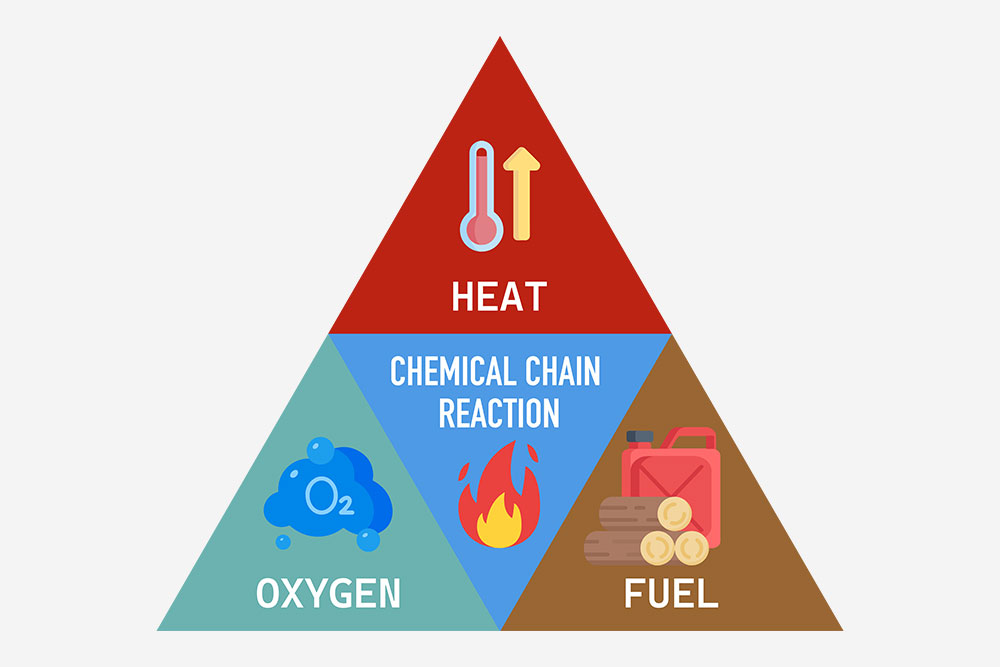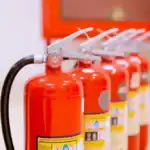
To prevent fires, it’s necessary to understand how they start and burn. Two concepts that explain this are the fire triangle and fire tetrahedron. They help visualise how fires burn and, more importantly, how they can be extinguished.
This blog looks at the differences between these two models and how knowledge of the fire tetrahedron can make your workplace safer. We also cover the importance of fire extinguishers and fire safety training in preventing workplace fires.
What is the Fire Triangle?
The fire triangle is a simple model to understand fires. It shows the three elements needed for a fire to start and burn: heat, fuel and oxygen.
- Heat: The energy needed to raise a combustible material to its ignition point. It can come from many sources in the workplace, including electrical equipment, machinery, heaters and lighting.
- Fuel: The combustible material that can burn, like paper, fabric or chemicals.
- Oxygen: Supports the chemical reaction that is fire. It’s in the air around us.
While this might be interesting, the fire triangle is mostly used to explain the fundamentals of fire prevention and fighting:
- Stop the three elements from meeting and a fire won’t start.
- Take any one of the elements away and a fire will go out.

What is the Fire Tetrahedron?
The fire tetrahedron is an updated model of the fire triangle. It includes heat, fuel, oxygen and a fourth element: the chemical chain reaction.
Fire is a combustion reaction between fuel and an oxidant, typically oxygen in the air. If these two elements combine and are heated to a high enough temperature, a fire ignites – as shown in the fire triangle.
The heat generated by this fire causes the fuel to release gases. These gases mix with oxygen in the air, creating a flammable mixture. This mixture also ignites and triggers a series of quick chemical reactions. During these reactions, fuel and oxygen molecules break apart and form new compounds, releasing energy in the form of heat.
This heat causes more fuel to release gases, which mix with oxygen and continue the combustion reaction known as fire. This ongoing cycle is the chemical chain reaction that keeps a fire burning.
Certain fires can keep burning even after one of the three elements is removed. This shows that the fire triangle isn’t always enough to explain fire behaviour.
The fire tetrahedron was developed as a better model. It adds the chemical chain reaction as the fourth element. This development helps us understand fire better and shows an additional way to put out fires: breaking the chemical chain reaction.

Relevance to Workplace Fire Safety
Understanding the fire tetrahedron can significantly improve workplace fire safety, particularly in choosing the right fire extinguishers. Recognising all four elements – heat, fuel, oxygen and the chemical chain reaction – helps you select the right extinguishers for different types of fires that may break out in your workplace.
Here’s how understanding the fire tetrahedron aids in choosing the right fire extinguisher.
Fire Safety Training
Our Fire Safety Training course gives a basic understanding of fire prevention principles, the sources of ignition and fuel and safe systems of work to prevent fire hazards and accidents within the work environment.
General Combustibles (Class A)
Class A fires involve organic solids like paper, wood and fabric, and can be put out using water or foam Class A extinguishers. These extinguishers remove heat and cover the fuel, effectively breaking the fire triangle.
Flammable Liquids (Class B)
Class B fires involve flammable liquids, such as gasoline, oil and solvents. Workshops and storage facilities might face these risks. Class B extinguishers are designed to handle these fires by interrupting the chemical chain reaction, preventing the fire from spreading.
Flammable Gases (Class C)
These fires involve flammable gases, such as propane, butane and methane. They’re a risk in industrial settings and areas where gas cylinders are used. Class C extinguishers work by smothering the fire and stopping the chemical chain reaction.
Metal Fires (Class D)
Class D fires involve combustible metals such as magnesium, aluminium and sodium. Manufacturing plants and laboratories dealing with these metals need Class D extinguishers. These extinguishers use dry powder to smother the fire and break the chemical chain reaction, preventing the fire from reigniting.

Cooking Oils and Fats (Class F)
Class F fires involve cooking oils and fats, which are common in commercial kitchens. Water can make these fires worse, so Class F extinguishers use special agents to break the chemical chain reaction and safely extinguish the fire. They also discharge at a lower force than other extinguishers to minimise the risk of burning oils spreading.
Fire blankets are another option for tackling burning oils and fats. They can smother a fire and cut off the oxygen supply.
Electrical Fires (Class E)
Electrical fires are sometimes referred to as Class E, although this isn’t universal. In the UK and much of Europe, electrical fires aren’t given a separate class because electricity doesn’t actually burn. It’s actually the material surrounding the electrical source that ignites, such as plastic insulation, wiring or nearby flammable objects.
Regardless of classification, these fires require specialist extinguishers that are safe to use on live electrical equipment, such as CO₂ or dry powder. Water-based extinguishers must never be used due to the risk of electric shock.
Fire Triangle vs Fire Tetrahedron
The fire triangle and fire tetrahedron are two models used to explain how fires start and how they can be extinguished. While both are useful, they serve different purposes and help guide decisions in fire suppression.
The Fire Triangle: A Foundation for Basic Firefighting
The fire triangle identifies the three essential elements that a fire needs to burn: heat, fuel and oxygen. Remove any one of these and the fire should go out. This model is helpful when dealing with smaller fires, especially those involving everyday materials.
Class A fires involving wood, paper or fabric are a good example. You can put these fires out with water extinguishers, which douse the flames with water to:
- Absorb heat, thereby reducing the fire’s temperature
- Cool the fuel, lowering it below its ignition point
- Prevent the burning material from releasing flammable vapours
When the Triangle Model Isn’t Enough
Despite its usefulness, the fire triangle doesn’t explain why some fires continue burning even after removing one of the three elements. This is particularly true for fire types where adding water is ineffective or even dangerous. For example:
- Class B fires (flammable liquids): Water may spread the fire instead of putting it out
- Class C fires (flammable gases): Water has little impact on the gas and may not cool it quickly enough
- Class D fires (combustible metals): Some metals react violently with water, releasing heat and gases that can cause explosions
- Class E fires (electrical equipment): Water conducts electricity, risking electric shock
- Class F fires (cooking oils and fats): Water can cause rapid and violent flare-ups
In these cases, a more advanced understanding of fire behaviour is needed.
The Fire Tetrahedron: A More Complete Model
The fire tetrahedron builds on the triangle by introducing a fourth element: the chemical chain reaction. This addition helps explain why certain fires continue to burn, even when heat, fuel or oxygen has been removed.
Class D fires involving metals like magnesium behave this way. When water is applied, the metal can react violently, generating enough heat to break water molecules apart and release hydrogen gas. This hydrogen ignites easily, fuelling the fire even further. In such cases, removing a basic element isn’t enough – you must interrupt the ongoing chemical reaction with a specialist extinguishing agent.
Specialist extinguishing agents are designed to interrupt combustion in different ways:
- Dry powder extinguishers for Class D fires smother burning metals and isolate the reaction from oxygen and heat.
- Dry chemical extinguishers, such as potassium bicarbonate, interfere with flame propagation in Class B fires by disrupting the chemical chain reaction and blocking oxygen.
Applying the Right Model
Knowing when to apply each model is essential for choosing the right firefighting method:
- For straightforward fires, removing one side of the triangle (heat, fuel, or oxygen) is usually enough.
- For fires involving volatile fuels or sensitive environments, extinguishers that disrupt the chemical chain reaction are often the safest and most effective option.
This understanding is especially relevant in complex environments such as data centres, industrial plants and aircraft, where conventional suppression techniques could cause more harm than good.
Fire Safety Training
While the fire tetrahedron provides a deeper insight into how fires sustain themselves through the chemical chain reaction, most people don’t need to understand fire on a molecular level to maintain a safe environment.
Instead, workers need to know how to prevent fires in the first place and what to do should one happen.
Our online Fire Safety Training courses cover these essentials. It teaches fire prevention strategies, evacuation principles and how to choose and use the correct extinguishers in an emergency.
By investing in Fire Safety Training, you ensure that everyone in the workplace is equipped with the knowledge and skills to prevent fires and handle emergencies effectively.





















